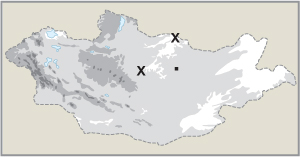
PLATE 49: TERNS II
Gull-billed Tern Gelochelidon nilotica
35–42 cm

ID Stocky, short-tailed, fairly large tern, best distinguished from other Mongolian terns in all plumages by short, thick, all-black bill. Non-breeding adult has diagnostic black mask/ear patch. Juv has stout dark bill with paler base, and buff tinge on upperparts. Voice In flight, gives a brief yapping kawick; at colonies a rattling growl. Habitat Nests on sandy shores of islands, lakes and rivers; uses other aquatic habitats with other tern species on migration. Behaviour Feeds largely on insects, hawking them on wing and picking them from water surface. Status Rare and local breeding visitor at lakes Uvs, Khar-Us, Khar and Dörgön (Great Lakes Depression) and Lake Höh in Ulz River valley, Dornod province, and rare passage migrant, mainly to northern Mongolia, south to Valley of the Lakes, late April to to early September.
Common Tern Sterna hirundo
34–37 cm

ID Mongolia’s most common and widespread tern species. Non-breeding adult, juv and first-winter could be confused with Whiskered Tern, but Common is one-third larger, with notably longer bill, wings and tail. Breeding adult Whiskered Tern has red bill, but in addition to being smaller than Common has dark grey breast and belly, sharply contrasting with white cheeks. Most Mongolian Common Terns belong to black-billed Asian subspecies S. h. longipennis, which might be confused with Gull-billed Tern. However, Common is darker grey, has more slender build, much longer tail and lacks Gull-billed’s short, heavy bill. Winter adult Common has black crown and nape (vs. Gull-billed’s black mask/ear patch. See also Arctic Tern). Voice A harsh drawn-out skreee-arrr; also a brief kyik kyik call. Habitat Nests on sandy and rocky shores of rivers and lakes as well as wet meadows, including aquatic habitats in steppe and Gobi Desert. Behaviour Colonial breeder sometimes with other gulls and terns. Gregarious on migration, often in mixed species flocks. Buoyant and graceful in flight; hovers and plunge-dives for prey. Status Common breeding visitor and passage migrant across Mongolia, late April to early September.
Arctic Tern Sterna paradisaea
33–36 cm

ID Very similar to Common Tern, from which it is distinguished by slightly smaller size; rounder head; smaller, all-deep-red bill; shorter legs; and long tail streamers extending well beyond wing-tips at rest (breeding adult). In addition to proportions, juv and winter birds best told by distinct narrow black trailing edge of primaries. Voice Shriller and squeakier version of Common Tern’s calls. Habitat Nests on Arctic shores and winters in southern hemisphere. Behaviour Similar to Common Tern. Status Vagrant. Two records, a bird at Lake Ögii, Arkhangai province, 5 June 2000, and one at Buur River, Selenge province (date unknown).
Little Tern Sternula albifrons
22–24 cm

ID Breeding adult unmistakable because of small size, short tail, yellow bill and white forehead contrasting with black cap. Non-breeding adult and imm distinguished from marsh terns by longer, narrower wings, extensive black in outer primaries, yellowish-brown legs and feeding behaviour. Voice A harsh and high-pitched kek, kyik and kirik-yik-kirik-yik. Habitat Nests on sandy or pebbly beaches of lake and river shores. Behaviour Distinctive jerky, fast-flapping flight. Plunge-dives and often hovers. Status Rare and local breeding visitor in Great Lakes Depression, Valley of the Lakes and Lake Buir, Dornod province, and rare passage migrant, late April to late August. Taxonomy Formerly placed in genus Sterna.